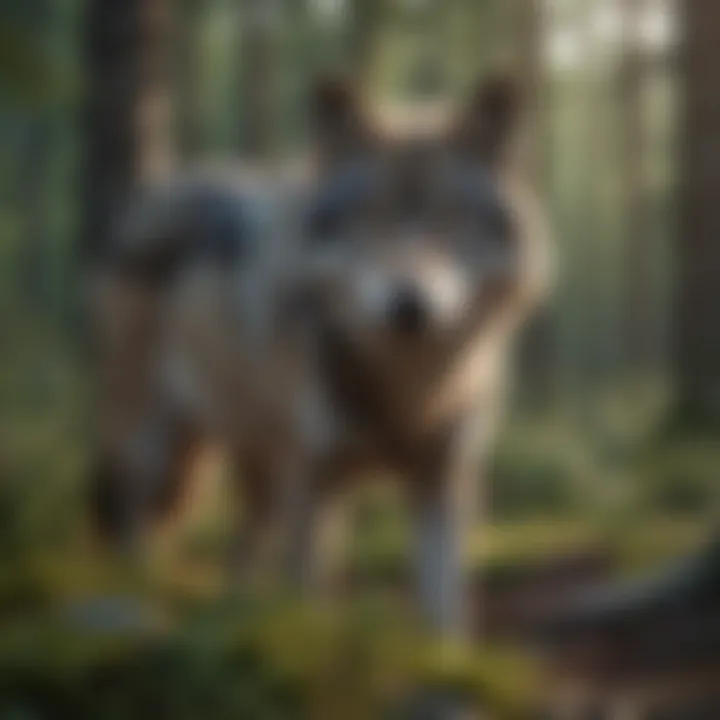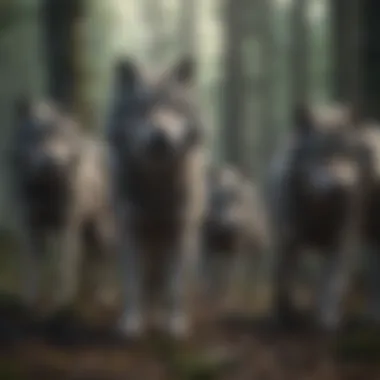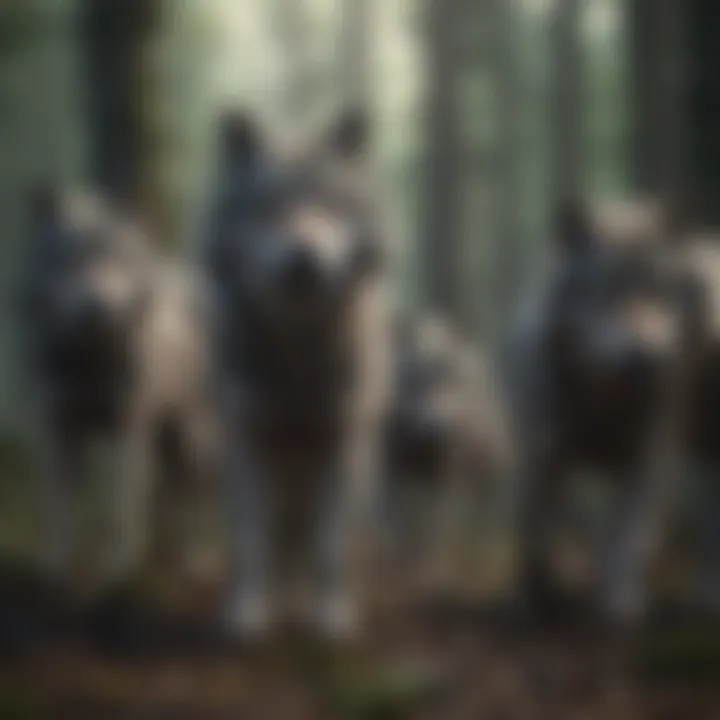The Diverse Adaptations of the Grey Wolf


Intro
The grey wolf (Canis lupus) stands as a remarkable example of adaptability in the animal kingdom. This species is known for its extensive range and success across various environments worldwide. Understanding its adaptations provides valuable insights into resilience and survival amidst changing ecological landscapes.
In this article, we shall delve into a comprehensive exploration of the adaptations exhibited by the grey wolf. These adaptations are not merely physical; they encompass physiological, social, and behavioral aspects that enhance its ability to thrive as a predator. Through this examination, we aim to reveal the evolutionary mechanisms that have shaped the species, highlighting the grey wolf's critical role within its ecosystem.
This investigation is particularly relevant for students, researchers, educators, and professionals interested in wildlife conservation and ecological studies. The multifaceted nature of the grey wolf's adaptations serves as an essential case study in understanding broader ecological principles and conservation strategies.
Prelims to Grey Wolves
The grey wolf (Canis lupus) represents an intriguing subject of study due to its unique and diverse adaptations. Understanding these adaptations is vital for several reasons. Firstly, they provide insight into the evolutionary history of the species as well as its behavioral ecology. Secondly, they inform conservation efforts aimed at protecting this keystone predator within various ecosystems.
Grey wolves are among the few large carnivores that exhibit salient flexibility in their adaptations. This flexibility allows them to thrive in a range of environments, from tundras to forests. By examining their ecological, physiological, social, and behavioral traits, we can better appreciate how grey wolves maintain their roles as apex predators and crucial components of their habitats. The adaptations also underscore the necessity of preserving their ecosystems for future generations.
Taxonomy and Species Distribution
The taxonomy of grey wolves is quite complex. They belong to the family Canidae and the genus Canis. Within Canis lupus, there exist several subspecies, each adapted to its environment. The most recognized subspecies include the Arctic wolf, the Eurasian wolf, and the Mexican wolf. Each of these subspecies showcases distinct adaptations that enable them to survive in their specific habitats.
The distribution of grey wolves is vast. Historically, their range spanned much of North America, Europe, and Asia. However, human activities have led to significant reductions in their populations and habitats. Today, grey wolves primarily inhabit national parks and protected areas where they can find prey and shelter. The resurgence of wolf populations in certain regions has catalyzed discussions surrounding wildlife management and ecosystem health, highlighting the role these creatures play in maintaining biodiversity.
Historical Context and Reintroduction Efforts
Historically, grey wolves were widespread across the Northern Hemisphere. However, excessive hunting and habitat destruction in the late 19th and early 20th centuries dramatically decreased their numbers. This decline led to extirpation in many areas, particularly in the contiguous United States. The loss of grey wolves disrupted ecosystems, contributing to overpopulation of prey species like deer.
Reintroduction efforts, notably in Yellowstone National Park in the mid-1990s, have been instrumental in revitalizing wolf populations. The project's success demonstrated the ecological balance that grey wolves maintain. As they reestablished territory and hunting behaviors, ecosystems flourished, leading to a reduction in overgrazing by herbivores, thus promoting plant diversity. Such efforts highlight the importance of grey wolves not only in their own right, but also in the broader context of environmental science and wildlife conservation.
"Understanding the historical context of wolf populations allows for informed and effective conservation strategies that benefit both the species and the ecosystems they inhabit."
"Understanding the historical context of wolf populations allows for informed and effective conservation strategies that benefit both the species and the ecosystems they inhabit."
Both taxonomy and historical context offer crucial insights into the significance of grey wolves in our ecosystems today. The ongoing efforts to conserve and reintroduce them reflect a growing recognition of their ecological importance in driving healthy wildlife dynamics.
Ecological Adaptations
Ecological adaptations are critical for the survival of the grey wolf in various environments. These adaptations allow the wolf to occupy diverse habitats, from forests to grasslands and tundras. Understanding these adaptations offers insights into the species’ resilience and evolutionary strategies. The grey wolf's adaptability is not just a necessity for survival but a complex interplay of ecology and behaviour that shapes its role in the ecosystem.
Habitat Flexibility
Grasslands
Grasslands offer a unique environment where grey wolves can thrive. These open areas provide visibility, making it easier for wolves to spot prey. Additionally, the absence of dense vegetation allows wolves to use their speed and endurance to chase and capture animals such as deer and bison. The key characteristic of grasslands is their expansive space, which facilitates pack dynamics during hunts. However, the primary disadvantage comes in the form of seasonal changes, where harsh weather may deter prey movement, impacting food availability.
Forests
Forests represent another important habitat for grey wolves. The dense foliage and varied terrain provide excellent cover for hunting and evading potential threats. Wolves can utilize their senses effectively in this environment, relying on auditory and olfactory cues to locate prey. A key advantage of forests is their biodiversity; wolves often share ecosystems with various species, allowing for strategic hunting opportunities. On the flip side, the complexity of the forest can make tracking prey more difficult, requiring higher energy expenditure during hunts.
Tundras
Tundras present a harsh yet fascinating habitat for grey wolves. The key feature of tundras is their extreme cold and minimal vegetation, which influences prey availability. However, the seasonal migrations of animals like caribou create feeding opportunities for wolves. The adaptability of wolves to this environment reflects their physiological resilience. Nevertheless, the tundra's lack of cover poses challenges for stalking prey, requiring wolves to utilize cooperative pack tactics for successful hunts.
Dietary Versatility


Hunting Strategies
Hunting strategies encompass the behaviors and methods wolves employ to capture their prey. A distinctive characteristic is pack cooperation; wolves often hunt in groups, coordinating their movements to encircle and fatigue their target. This social structure enhances their success rate during hunts. Hunting strategies significantly contribute to the grey wolf's adaptability, as wolves can adjust their tactics based on the type of prey and environmental conditions. However, the reliance on coordinated efforts can be a disadvantage if pack members are injured or if they face a lone animal that can defend itself effectively.
Scavenging Behavior
Scavenging behavior plays a crucial role in the dietary versatility of grey wolves. This allows them to utilize resources that are not actively hunted, such as carrion left by other predators. The key characteristic of scavenging is its energy efficiency; wolves can feed when prey availability is low. This adaptation is particularly beneficial during winter months when hunting becomes challenging due to snow cover. An advantage of this behavior is the opportunity to access high-calorie carrion; however, it can also come with risks, including competition from other scavengers and disease transmission.
Physiological Adaptations
Physiological adaptations play a crucial role in the survival and success of the grey wolf. These adaptations enhance their ability to regulate body functions in response to environmental pressures. Through various mechanisms, grey wolves maintain their physical health, optimize their hunting capabilities, and increase their resilience to changing habitats. This section will delve into thermoregulation mechanisms and sensory adaptations that are vital for their survival.
Thermoregulation Mechanisms
Fur and Insulation
Fur serves as the primary form of insulation for grey wolves. It provides protection against cold temperatures, allowing them to thrive in harsh environments like the Arctic tundra or dense forests. One of the key characteristics of this fur is its density; it is thick and layered, which traps air and retains heat. This characteristic makes fur an optimal choice for this article, as it illustrates the adaption of wolves to diverse climates.
Moreover, the unique feature of changing fur color with seasons serves as both camouflage and insulation. In winter, grey wolves may grow a thicker, lighter-colored pelage, helping them blend into snowy landscapes while keeping warm. The advantage of such insulation mechanisms is evident; it enables wolves to engage in their natural behaviors without the constraints of extreme cold, maximizing their hunting efficiency.
Circadian Rhythms
Circadian rhythms are internal processes that regulate the sleep-wake cycle and other physiological activities over a 24-hour period. For grey wolves, these rhythms are vital, enhancing their ability to hunt in tune with their prey's behavior. A key characteristic of these rhythms is the adaptability based on environmental cues such as light and temperature.
Owls and other vocational predators often exhibit nocturnal hunting, but grey wolves can adapt their patterns based on prey availability. This flexibility is beneficial, allowing them to capitalize on various hunting windows. The unique feature of circadian rhythms in wolves is their ability to shift from diurnal to nocturnal activity. This presents advantages; however, it also poses challenges, such as energy expenditure during atypical hunting hours.
Sensory Adaptations
Olfactory Sensitivity
Olfactory sensitivity is among the most refined senses in grey wolves. Their ability to detect scents over several kilometers makes them incredibly proficient hunters and scavengers. The key characteristic of this adaptation lies in their olfactory receptors; grey wolves possess an estimated 300 million olfactory receptors compared to about five million in humans. This heightened sensitivity is particularly advantageous for locating prey, identifying territories, and recognizing pack members.
A unique feature of their olfactory system is its capability to differentiate various scents. This allows wolves to track other animals effectively and determine their physical condition or sexual readiness. The advantages of strong olfactory sensitivity cannot be overstated; it provides wolves with critical information necessary for survival and successful reproductive strategies.
Hearing Adaptations
Hearing adaptations are equally significant for grey wolves. They have acute hearing abilities, capable of detecting sounds at frequencies beyond human perception. The key characteristic of these adaptations is the structural uniqueness of their ears, which are designed to funnel sound waves more effectively.
This enhanced hearing capability allows wolves to pick up subtle sounds, such as prey movements or calls from pack members. The unique feature of their auditory sensitivity is its integration with their social dynamics, enabling effective communication and coordination during hunts. One advantage of keen hearing is that it helps wolves determine the direction and distance of sounds, ultimately informing their strategic movements. However, exposure to high-frequency sounds in urban areas can present challenges for their hunting success.
Grey wolves adapt through various physiological mechanisms, enhancing their survival in complex and changing environments. Their fur insulation, circadian rhythms, olfactory sensitivity, and hearing adaptations collectively illustrate their evolutionary prowess.
Grey wolves adapt through various physiological mechanisms, enhancing their survival in complex and changing environments. Their fur insulation, circadian rhythms, olfactory sensitivity, and hearing adaptations collectively illustrate their evolutionary prowess.
Social Structure and Pack Dynamics
Understanding the social structure and pack dynamics of grey wolves is crucial to appreciating their adaptability and survival. The grey wolf, a social animal, displays unique behaviors within its groups that enhance its ability to thrive in various environments. The social system of these wolves plays a significant role in their hunting success, territorial defense, and breeding behaviors. This section will delve into the complexities of pack formation, hierarchies, and cooperative strategies that contribute to the overall fitness of the species.
Pack Formation and Hierarchies
A wolf pack typically consists of a family unit, often including a breeding pair and their offspring. The core structure enhances not only reproduction but also the sharing of resources and responsibilities. The formation is dynamic, as packs can grow or shrink due to various factors such as birth rates and environmental pressures.
Wolves establish clear hierarchies within their packs. The alpha pair leads the group, while other members have specific roles. These roles are determined by age, strength, and social interactions. The hierarchies are not fixed; they can change based on several variables like the introduction of new wolves or leadership challenges.


The alpha pair, often the strongest individuals, makes essential decisions regarding hunting and territory. Subordinate wolves work collaboratively under the leadership, facilitating a stable pack environment. The social structure aids in mitigating conflicts over resources and provides a framework for cooperative behaviors.
Cooperative Hunting Strategies
Cooperative hunting is a significant adaptation that enhances the grey wolf's ability to catch prey, particularly larger animals. This strategy involves extensive communication and a high level of coordination among pack members. Each member plays a distinct role during hunts, which increases the overall effectiveness of the group's efforts.
Wolves employ various tactics, such as flanking and ambushing, individually assessing prey's vulnerabilities. They can adapt their strategies based on the group size and the specific behaviors of the prey. This flexibility is crucial, as it allows wolves to hunt efficiently in diverse environments.
Furthermore, successful hunts not only provide food but also maintain pack bonds. Sharing a kill reinforces social structures and nurtures relationships within the pack. Cooperative behaviors extend beyond hunting, impacting overall survival rates and contributing to the longevity of the species.
"Wolf packs exemplify one of nature's most successful social structures, reflecting the importance of teamwork and collaboration in survival."
"Wolf packs exemplify one of nature's most successful social structures, reflecting the importance of teamwork and collaboration in survival."
Behavioral Adaptations
The behavioral adaptations of the grey wolf play a significant role in its survival and success across various ecosystems. These adaptations are crucial, as they allow wolves to respond effectively to environmental pressures, maintain social structures, and communicate within packs. Each behavior serves a specific purpose, ensuring the species can thrive under varying circumstances and adapt to changes in their surroundings.
Communication Mechanisms
Vocalizations
Vocalizations are fundamental for communication among grey wolves. They use a variety of sounds, including howls, barks, whines, and growls. Howling is perhaps the most recognized vocalization. It serves multiple purposes, including rallying the pack, marking territory, and possibly strengthening social bonds. The unique feature of howling is its ability to transmit sound over long distances, which makes it a very effective method for communication in extensive ranges.
This ability to vocalize allows for coordination during hunts and for alerting pack members to danger. It provides an advantage in both social interaction and survival strategies. However, howling can also attract unwanted attention from rival packs or human hunters, highlighting a potential risk associated with this communication method.
Body Language
Body language is another critical aspect of how wolves communicate. This includes postures, facial expressions, and tail movements. Dominance displays, such as raising the tail or baring teeth, signal social hierarchies within the pack. The key characteristic of body language is its immediacy. Unlike vocalizations, body language communicates messages in real-time, allowing for quick responses to social dynamics.
For instance, a wolf standing tall may indicate confidence or aggression, while a lower posture may suggest submission. This range of nuances helps to minimize conflict within the group and maintain social order. Nevertheless, reliance on body language can sometimes lead to misunderstandings, especially in interactions with other species, including humans.
Territorial Behavior
Marking Territory
Marking territory is a vital behavioral adaptation for grey wolves. Wolves use scent marking to communicate territorial boundaries to other wolves. This involves urinating on prominent features in the landscape, which signals to other packs that the area is claimed. The key aspect of this behavior is its role in reducing physical confrontations between packs, serving as a warning to intruders.
By establishing clear territorial lines, wolves can maintain access to resources like prey and shelter without constant conflict. This behavior helps preserve energy and reduce the risks associated with direct confrontations. However, the very nature of marking territory can lead to competition for limited resources, which may intensify conflicts in areas where populations are high.
Defensive Strategies
Defensive strategies are essential for a wolf pack's survival, especially in the face of threats from rivals or predators. This includes forming a defensive circle when threatened, which allows them to protect vulnerable members, particularly pups. The key characteristic of these strategies is their adaptability; wolves can vary their response based on the nature of the threat.
For example, when faced with potential danger, wolves often use intimidation tactics, such as growling and displaying teeth. They may also decide to retreat if the odds are unfavorable, showcasing their ability to assess situations carefully. While these strategies provide essential survival tactics, the effectiveness depends on the pack's size and cohesion, making them vulnerable during periods of division or weakened social structure.
Impact of Environmental Changes
The study of the grey wolf's adaptations cannot be comprehensive without examining the impact of environmental changes. These changes encompass several aspects, including climate dynamics and alterations in habitat structures. Understanding these impacts is crucial as they play a significant role in shaping the survival strategies of the grey wolf. As pressures mount from both natural and anthropogenic sources, the grey wolf's resilience is tested. This analysis highlights not only the importance of the wolf within its ecosystem but also underscores the delicate balance of ecological interactions affected by environmental shifts.
Climate Change Impacts
Climate change is a pressing concern that affects various species, including the grey wolf. Rising temperatures and altered precipitation patterns can influence prey availability and habitat suitability. Many wolf territories span vast areas, and changes in climate can shift the distribution of their prey, such as ungulates.


- Prey Dynamics: Changing climates can lead to shifts in where prey species migrate or breed. For instance, if deer populations move further north due to warmer temperatures, wolves must adapt to follow these changes.
- Habitat Shift: As habitats change, wolves may find traditional hunting grounds diminished. In some areas, reduced snow cover can hinder hunting strategies that rely on tracking.
- Disease and Competition: Warmer climates can also lead to the spread of diseases that affect both wolves and their prey. Furthermore, competition with other predators may intensify as species react differently to climate stresses.
"The adaptability of wolves in the face of climate change speaks to their evolutionary success, yet it does not guarantee survival."
"The adaptability of wolves in the face of climate change speaks to their evolutionary success, yet it does not guarantee survival."
Habitat Fragmentation and Loss
Habitat fragmentation poses another significant challenge for grey wolves. As urbanization and land development expand, habitats become increasingly divided. This fragmentation can lead to several consequences:
- Isolation: Smaller, isolated wolf populations may face challenges related to genetic diversity. Reduced gene flow makes them more susceptible to diseases and decreases their overall adaptability.
- Increased Human Interaction: Fragmented habitats often mean closer proximity to human populations. This increase can lead to more human-wolf conflicts as wolves venture into urban areas in search of food.
- Disruption of Movement: Wolves require large territories to thrive. Fragmented environments can restrict their natural movements and reduce their ability to hunt effectively.
The implications of habitat loss and fragmentation extend beyond the wolves themselves, affecting entire ecosystems. By understanding these factors, conservationists can better strategize efforts to mitigate these threats and promote the survival of grey wolves in a rapidly changing world.
Conservation and Human-Wolf Conflict
Conservation of the grey wolf, Canis lupus, and the management of human-wolf conflict are critical elements in the ongoing efforts to sustain the species in the wild. This section delves into the importance of these topics, highlighting the need for balanced perspectives on wildlife conservation and the necessity to address conflicts between wolves and human interests. With both ecological and socio-economic implications, an effective conservation strategy is vital for ensuring the grey wolf's survival while also respecting the needs of local communities.
Conservation Efforts and Policies
Conservation strategies for grey wolves often encompass a variety of approaches, focusing on habitat protection, legal frameworks, and community engagement. Policies can vary widely, depending on the geographical locations and social contexts of wolf populations. Important policies include:
- Endangered Species Act: In the United States, this act plays a significant role in protecting grey wolf populations. Reintroduction programs, such as those in Yellowstone National Park, have shown how legal protection can facilitate recovery.
- Habitat Conservation Plans: Managing land use is essential to reduce habitat fragmentation. These plans often involve collaboration between government agencies, conservationists, and local stakeholders to balance ecological needs with human activities.
- Public Education and Awareness Campaigns: Engaging communities around the importance of wolves in ecosystems can foster local support for conservation efforts. Education helps dispel myths and fears about wolves, which can lead to more positive human perceptions.
Conservation efforts are not just about protecting wolves; they also consider the entire ecosystem, recognizing that wolves play a crucial role as apex predators. This balance can lead to healthier wildlife populations and improved ecosystem function.
Mitigation Strategies for Human-Wolf Conflicts
Addressing human-wolf conflict is vital for the cohabitation of humans and wolves. Conflicts can arise from livestock predation, fear of attacks, and misconceptions about wolves. Several strategies can help mitigate these issues:
- Non-lethal deterrent measures: The use of guard animals, fencing, and sound devices can effectively deter wolves from livestock. These methods provide alternatives to lethal control and foster coexistence.
- Compensation programs: Providing financial compensation for livestock lost to predation can alleviate economic burdens on farmers and ranchers. This method acknowledges the role of wolves in the ecosystem while supporting local economies.
- Community collaboration: Involving local communities in decision-making processes about wolf management can result in more effective strategies. Educating communities on wolf behavior and ecological role encourages understanding and reduces fear.
- Research and monitoring: Ongoing studies of wolf populations and interactions with humans can lead to adjustments in management policies. Understanding when and why wolves may prey on livestock helps formulate targeted solutions.
"For conservation efforts to succeed, the needs of both wildlife and human populations must be carefully balanced."
"For conservation efforts to succeed, the needs of both wildlife and human populations must be carefully balanced."
Overall, successful conservation of grey wolves is intertwined with effective conflict management. Engaging with local communities, developing robust policies, and implementing innovative solutions can create a sustainable coexistence, benefiting both the species and the ecosystem as a whole.
End and Future Directions
Understanding the grey wolf's adaptations is vital for multiple reasons. These adaptations reveal how the species has thrived in diverse environments, which is crucial for conserving biodiversity. As ecosystems face mounting pressures from climate change, habitat destruction, and human-wolf conflicts, understanding these adaptations can inform management practices and conservation strategies. Key adaptations of the grey wolf not only enhance its survival but also function as a model for studying evolutionary biology. This knowledge is intrinsic for formulating effective conservation policies that address the needs of both wolves and human communities.
Summary of Key Adaptations
The grey wolf possesses a remarkable suite of adaptations that allow it to excel as a top predator. These adaptations can be summarized into several key areas:
- Ecological Flexibility: Grey wolves occupy various habitats, including grasslands, forests, and tundras. This flexibility aids in their distribution across a wide geographical range.
- Dietary Versatility: As opportunistic feeders, grey wolves employ multiple hunting strategies and scavenging behaviors. This versatility ensures their survival even in changing ecological circumstances.
- Physiological Specializations: The wolf's fur provides insulation, while its acute senses, particularly olfactory and auditory, enhance its ability to locate prey and communicate.
- Complex Social Structure: Wolves exhibit a hierarchical pack system, which is essential for cooperative hunting and territorial defense.
Understanding these adaptations sheds light on the integral role that grey wolves play in maintaining the balance of their ecosystems.
Implications for Future Research
Future research on grey wolves should focus on various fronts. Studies could investigate the impact of climate change on their habitats. As temperatures rise and weather patterns shift, wolves may need to adapt or migrate, altering their ecological role. Furthermore, research should explore the genetic diversity within populations. Understanding genetic resilience will be key to ensuring the long-term survival of the species. A multidisciplinary approach that combines ecological, genetic, and anthropological insights can yield comprehensive strategies for conservation.
Additionally, ongoing monitoring of human-wolf interactions is crucial. Insights gained from these interactions can facilitate effective mitigation strategies, ensuring coexistence between humans and wolves. By acknowledging the evolutionary significance of the grey wolf's adaptations, researchers can contribute to broader conservation efforts aimed at preserving ecosystems globally.
"Effective conservation begins with understanding the intricate balance between species and their environment."
"Effective conservation begins with understanding the intricate balance between species and their environment."



